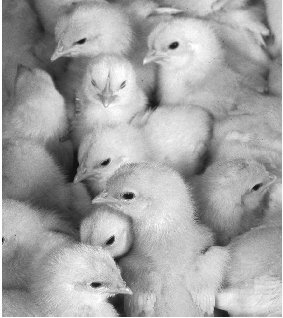Chapter 1
Inheritance

In legal terms, inheritance describes the wealth that parents leave, or pass on, to their children. In biology, the word refers to the genetic processes by which parents endow their children with specific traits, like height, hair color, eye color, and other characteristics. It is an everyday observation that children tend to resemble their parents in many ways, but it is equally obvious that the resemblance is not a simple one. Tall parents do not always produce tall children; children with blue eyes do not necessarily have parents with blue eyes.
Similarity and Difference
Yet, in humans and all other biological organisms, there are clear similarities between one generation and the next: Dogs always give birth to dogs; acorns always develop into oak trees; when a chicken's egg hatches, an infant chicken—not a duck or an eagle—emerges from the shell. In other words, each species, or type of organism, produces members of the same species. Striking similarities also exist within species. Every normal cat has four legs, humans have two, and spiders have eight. Despite these similarities, no two individuals of the same species (except for identical twins or triplets) are carbon copies of each other.
Genetics is the science that explains these similarities and differences. It even explains those rare and often tragic cases where a member of a species is born with physical abnormalities. It does so through

Although Mendel published the results of his work with peas almost a century and a half ago, his experiments are still regarded as masterpieces of scientific method. "While others . . . pondered the huge complexities and confusions of heredity, Mendel perceived that no one would make any progress until they first identified and worked out the simplest possible cases," says science writer Colin Tudge. "Never, in short, in all of science have experiments been more beautifully conceived and executed. This is not the simplicity of a simple man, but of a genius, who sees the simplicity that lies behind the surface incoherence." 2
That in essence is what science does. It seeks to find simple rules to explain phenomena that on the surface appear to be very complex. When these rules are confirmed by numerous experiments, they are classified as laws. Most scholars agree that the paper in which Mendel recorded the results of his eight years of work with garden peas remains a completely up-to-date discussion of the laws of heredity. "With peas, the simplest possible case, he worked out the ground rules," Tudge says. "But he knew . . . that most cases were more complicated. He wanted to find rules that were universal. I'm sure he felt in his bones that the rules he derived from peas were universal, and that with a little tweaking they could explain the odd patterns of inheritance in beans and bees and, indeed, in human beings." 3
Reproduction
Some organisms—bacteria, for example—are made up of just a single cell. These life-forms reproduce by a relatively simple process of cell division. Stimulated by internal chemical processes, the solitary cell divides to produce an exact replica, or clone, of itself. The genes contained in the replica are identical to those in the original. Depending on the type of organism involved and the environment in which it is living, cell division can recur a virtually limitless number of times, creating countless identical living things.
However, plants and animals—including human beings—reproduce sexually. That is, genetic material from both a male and a female parent is required to produce a new member of the species. One of the consequences of sexual reproduction and the transfer of genetic information that it entails is that offspring are different from their parents and from each other. Every individual produced in this way, except for identical twins and triplets, is unique.
To arrive at the principles underlying the transmission of traits from parents to their offspring in sexual reproduction, Mendel chose to study garden peas. He focused on seven traits that were easy to observe and, in garden peas, come in two distinct varieties: (1) seed shape, which is either round or wrinkled; (2) seed color, yellow or green; (3) flower color, purple or white; (4) pod shape, inflated or pinched; (5) pod color, green or yellow; (6) stem height, tall or short; and (7) flower position, at the end of the stem or off to the sides.
In order to fully appreciate the laws of inheritance, it is necessary to understand that plants, like people, have male and female sexual organs. However, unlike in people, both sex organs can occur on the same plant. This allows the plant to fertilize itself as well as be cross-fertilized by another plant. The sex organs are located in the flower of the plant. The male organs, called the anthers, produce pollen, which contains the male sex cells, or sperm. When fertilization occurs, pollen is transferred from the anthers to the female organ, called the stigma, where it combines with a female sex cell, or egg.
Mendel's Experiments
In nature, cross-fertilization (also called crossbreeding) occurs when a bee or other insect (or even the wind) transfers pollen from one plant to another. Mendel used a small brush to accomplish this chore. He set himself the task of cross-fertilizing plants with contrasting traits—tall with short, yellow-seeded with green-seeded, and so on—and tabulating the results. He realized that he would have to observe a large number of crossbreedings to compensate for the possibility that some of the results might be due to flukes like unintended wind-borne fertilization. By the time his eight-year experiment was over, he had carefully recorded the results of twenty-eight thousand crossbreedings.
As further insurance against false results, he also made sure that the plants he started with were pure-breeding, another way of saying that for generations they had produced only one version of each of the traits he was interested in. "He had a bunch of plants with yellow seeds that produced only plants with yellow seeds when bred to each other," explains geneticist R. Scott Hawley. "Similarly, he had a bunch of plants with green seeds that produced only plants with green seeds when bred to each other." 4
When Mendel looked at the first generation of plants produced by his pairings, he found immediate confirmation of his belief that the blending theory of heredity was wrong. The first trait he looked at was seed shape. All the plants produced by crossbreeding round-seed and wrinkle-seed plants had round seeds. Similarly, the mating of tall plants with short ones produced plants that were all tall. There were no intermediate specimens—no seeds that were somewhat wrinkled and no plants whose height fell between that of its tall and short parents.
Discussing seed color, Hawley says,
In the first generation, when Mendel crossed plants with green seeds to plants with yellow seeds, all he saw in the progeny were plants with seeds identical in color to those of the green-seeded parent. It didn't matter which way the cross was made (i.e., green males crossed to yellow females or vice versa), all the offspring had green seeds. . . . A real adherent to blending would have postulated that the progeny of the first generation should have been yellowish-green, not true green. 5
One Gene, Two Variants
This part of Mendel's experiment established the first principle of inheritance. If genetic material was not blended, then it had to be passed on in discrete units. These units—Mendel called them factors, but they are now referred to as genes—retained their individual identity in the newly created organisms, which could then pass them on to succeeding generations. The second, and equally important, principle of inheritance came to light when Mendel bred second-generation plants to themselves and each other. Traits—yellow seeds and shortness, for example—that had vanished in the second generation suddenly reappeared in the third.
With respect to height, one out of every four third-generation plants was short. Mendel obtained similar ratios for the other traits he was studying. "In the subsequent generation, green-seeded plants crossed to themselves or each other produced both yellow and green-seeded plants," Hawley explains.
In order to explain differences in traits, Mendel supposed that genes could take different forms, called alleles, that specified different expressions of the trait. For example, Mendel claimed that there was a gene that gave seed color and two different forms or alleles of that gene: one specifying green color and one specifying yellow color.
In addition, an individual must be able to carry genetic information for a trait it does not express. (We know that the green-seeded progeny [offspring] produced by the first generation carried the information to produce yellow seeds because they were able to pass it on to the yellow-seeded progeny in the next generation.) Mendel's second insight was that this pattern of inheritance could only be explained if the green alleles could mask the expression of the yellow alleles, such that individuals getting a green allele from mom and a yellow allele from dad would be just as green as those that got green alleles, and only green alleles, from both parents. . . . To denote this difference between the ability of alleles to determine a [trait], Mendel introduced the terms dominant and recessive. 6
That every gene comes in two varieties, a dominant form and a recessive form, explains the ability of traits to skip generations. Each parent passes on one allele of each gene to each child. A child who inherits two dominant alleles for a given trait will exhibit that trait. A child who inherits one dominant and one recessive allele will also exhibit the trait because the dominant allele will mask the presence of the recessive allele. Only if the child inherits two recessive alleles will the dominant trait not appear.
Dominant and Recessive Traits
The propensity for red hair, for example, could be lurking in recessive form in the genes two nonredheaded parents pass along to their children. Those children will, in turn, pass it on to their children. Should one of those children grow up and marry someone also carrying the recessive form of the gene, and should they both pass on the recessive form to their offspring, redheadedness will suddenly emerge after an absence of several generations in the family tree.
The height of garden pea plants illustrates this point clearly. With respect to the gene that governs this trait, the dominant allele leads to tallness and the recessive allele leads to shortness. A pea plant will be tall if it inherits the dominant (tall) allele of the gene from each of its parent plants. It will also be tall if it inherits one dominant (tall) allele and one recessive (short) allele. Only if it inherits two recessive alleles will it be short.
This insight is one of the cornerstones of modern genetics: Rather than blending in offspring, genes are inherited from parents as discrete units that come in two forms, each of which is passed on separately and remains separate in the genetic makeup of the new individual. This means that recessive traits can be passed on from generation to generation without leaving a visible trail.
"Mendel concluded that the hereditary determinants for the traits in the parental lines were transmitted as two different elements that retain their purity in the hybrids [the plants resulting from crossbreeding]," says geneticist Daniel L. Hartl. "In other words, the hereditary determinants do not 'mix' or 'contaminate each other.' The implication of this conclusion is that a plant with the dominant trait might carry, in unchanged form, a hereditary determinant for the recessive trait." 7
Segregation and Assortment
In humans, for example, a dimpled chin is caused by a dominant allele. A person with a dimpled chin has either one or two dominant alleles for this trait. The absence of a dimple indicates that two recessive alleles are present in the person's genetic makeup. However, since someone with a dimpled chin might have a recessive allele for that trait, it is possible for that person to pass it on to a child. Should that child's other parent also contribute a recessive allele for this trait, the child would have a dimpled chin.
This property of genes, that they each come in two different forms or alleles and that each parent contributes one allele to the genetic makeup of his or her children, is called the principle of segregation. Support for this principle came in the twentieth century when biologists discovered that when sex cells—male sperm and female eggs—are formed, each carries

Another important law of inheritance, also discovered by Mendel and proved by subsequent research, is called the principle of independent assortment. In conducting his experiments with peas, Mendel noticed that traits were inherited independently of each other. In other words, whether a plant was tall or short had no effect on whether its seeds were green or yellow. This is because the traits he was looking at are caused by genes that are located on different chromosomes (structures in each of an organism's cells). Mendel was not in a position to know this fact, but it was proved when the structure of cells was determined in the decades after he completed his work.
Exceptions to Mendel's Rules
While it is true that Mendel's description of the principles of genetic inheritance has been confirmed by tens of thousands of experiments on plants and animals, it is also true that the transmission of genetic information from one generation to another is somewhat more complex than he realized. In certain cases, called incomplete dominance, the inheritance of both a dominant and a recessive allele of a gene does produce what appears to be a blend of traits.
Certain flowers, for example, come in three colors. When a dominant and a recessive allele for the gene that determines color combine, the result is a shade intermediate between the two other colors that the flower can assume. Although this seems to suggest that a blending of genetic material has occurred, it has not. It is simply a property of these flowers' genes to produce three colors and not two, as Mendel's peas did.
Another subtlety that escaped Mendel has come to be known as quantitative inheritance. The traits he studied were very easy to observe: A seed was either green or yellow, a plant was either tall or short. Each of these traits was caused by a single gene. Some characteristics, however, do not lend themselves so easily to either-or classification. Human skin color, to take an obvious example, comes in a wide range of shades. Scientists now know that these traits are determined by more than one gene. It is the combined effect of all the relevant genes that produce the characteristic, allowing for more variation than occurs when only single genes are involved.
The rules of inheritance that Mendel discovered—that genetic material is passed from generation to generation in discrete units, that these units come in two forms called alleles, that each parent contributes one allele for each gene to the offspring, and that the units operate independently of each other—laid the groundwork for twentieth-century genetics. From his modest experiments with garden peas have come the breakthroughs that are revolutionizing biological science and our understanding of life itself.
Ms Kusum Jayaratne